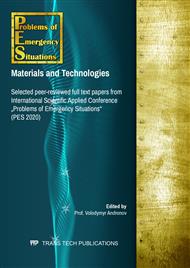[1]
DSTU-N B V.1.2-18:2016 Nastanova shchodo obstezhennya budivel i sporud dlya vyznachennya ta otsinky yikh tekhnichnoho stanu. Kyiv, 2017 [in Ukrainian].
Google Scholar
[2]
GOST 31937-2011 Mezhgosudarstvennyy standart zdaniya i sooruzheniya. Pravila obsledovaniya i monitoringa tekhnicheskogo sostoyaniya. Moskva, 2014 [in Russian].
Google Scholar
[3]
RD EО 1.1.2.99.0624-2017 Monitoring stroitelnykh konstruktsiy atomnykh stantsiy. Moskva, 2018 [in Russian].
Google Scholar
[4]
L.S. Permyakova, A.P. Epifanov, Formation of the stress-strain state of the Sayano-Shushenskaya hydroelectric dam during reservoir filling in 2010, Gidrotekhnicheskoye stroitelstvo. 4 (2011) 2-6.
DOI: 10.1007/s10749-011-0246-0
Google Scholar
[5]
Information on https://icentre-gfk.ru/naprd/naprd_asdm_op.htm.
Google Scholar
[6]
DSTU B V.2.7-226: 2009 Betony. Ultrazvukovyj metod vyznachennya mіtsnostі. Kyiv, 2010 [in Ukrainian].
Google Scholar
[7]
DSTU B V.2.7-220:2009 Betony. Vyznachennya mitsnosti mekhanichnymy metodamy neruynivnoho kontrolyu. Kyiv, 2010 [in Ukrainian].
Google Scholar
[8]
DSTU B V.2.7-223:2009 Betony. Metody vyznachennya mitsnosti za zrazkamy, vidibranymy z konstruktsiy. Kyiv, 2010 [in Ukrainian].
Google Scholar
[9]
Information on http://ndibmv.kiev.ua/monitoring-tekhnichnogo-stanu-budivel/.
Google Scholar
[10]
A.M.T. Hassan, S.W. Jones, Non-destructive testing of ultra-high performance fibre reinforced concrete (UHPFRC). A feasibility study for using ultrasonic and resonant frequency testing techniques, Construction and Building Materials. 35 (2012) 361-367.
DOI: 10.1016/j.conbuildmat.2012.04.047
Google Scholar
[11]
K. Schabowicz, Ultrasonic tomography – The latest nondestructive technique for testing concrete members – Description, test methodology, application example, Archives of Civil and Mechanical Engineering. 14(2) (2014) 295-303.
DOI: 10.1016/j.acme.2013.10.006
Google Scholar
[12]
Chen Jun, Zheng Xu, Yue Yu and Yangping Yao, Experimental characterization of granite damage using nonlinear ultrasonic techniques, NTD and E International. 67 (2014) 10-16.
DOI: 10.1016/j.ndteint.2014.06.005
Google Scholar
[13]
V. Kolokhov, A. Sopilniak, G. Gasii, A. Kolokhov Structure material physic-mechanical characteristics accuracy determination while changing the level of stresses in the structure, International Journal of Engineering &Technology. 7(4.8) (2018), 74-78.
Google Scholar
[14]
Y.A. Otrosh, Using a monitoring system to evaluate the technical condition of building structures, Budivnytstvo ta inzhenerni sporudy. 3 (2018) 1-7.
Google Scholar
[15]
R.A. Makarov, L.B. Renskiy, Tenzometriya v mashinostroyenii, Moskva, 1975 [in Russian].
Google Scholar
[16]
Rekomendatsii po prigotovleniyu elektroprovodyashchego betona NIIZHB GOSSTROYA SSSR. Moskva, 1983 [in Russian].
Google Scholar
[17]
V.V. Kolokhov, Some aspects of the application of methods for non-destructive testing of concrete properties, Theoreticаl Foundаtions of Civil Engineering. 20 (2012) 443-448.
Google Scholar
[18]
Y. Otrosh, A. Kovalov, O. Semkiv, I. Rudeshko, V. Diven, Methodology remaining lifetime determination of the building structures, MATEC Web of Conferences. 230 (2018) 02023.
DOI: 10.1051/matecconf/201823002023
Google Scholar


